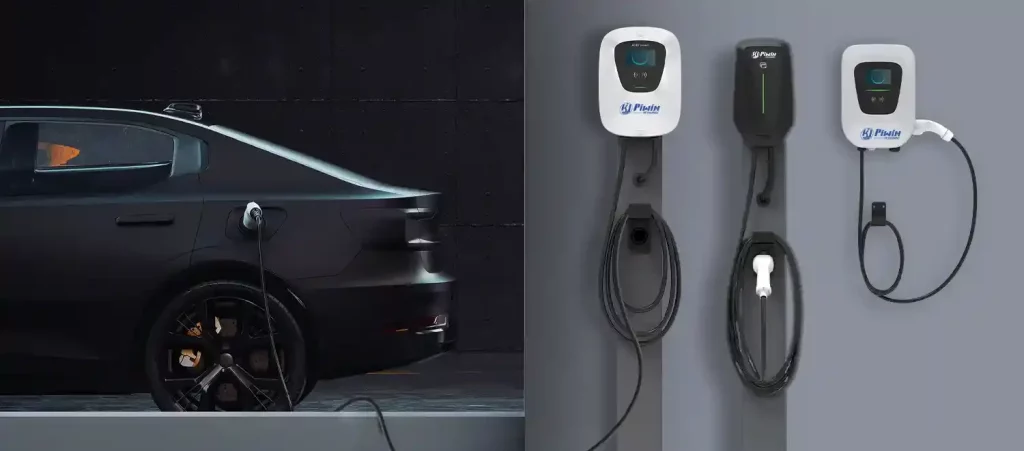
Products
Fast, Reliable, Everywhere

Solutions
Efficient, Innovative EV Charging Solutions.
News
We are committed to the innovation and application of EV charging.
Electric vehicles (EVs) are becoming increasingly popular, offering an eco-friendly alternative to gas-powered cars. As more drivers make the switch, EV charging infrastructure is expanding across the country. But if you’re new to EVs, you may find all the terminology around charging confusing. What exactly is an AC EV charger? And how is it different from other charger types?
In this complete guide, we’ll cover everything you need to know about AC EV chargers:
After reading, you’ll understand the key facts about AC EV charging and how to utilize AC chargers to power up your electric vehicle. Time to plug in and charge up on knowledge!

An AC EV charger is a charging station that supplies alternating current (AC) electricity to an electric vehicle. It charges the EV battery by converting the AC power to direct current (DC) using an onboard charger built into the vehicle.
AC chargers are commonly found in homes, workplaces, and public parking locations. They typically charge at a standard rate that will fully recharge an EV battery overnight or after it's parked for several hours.
The key thing that distinguishes AC EV chargers is that they supply AC electricity from the power grid and require conversion to DC before the battery can use it.
Wondering about the actual charging process with an AC station? Here’s a quick breakdown:
The conversion from AC to DC happens inside your EV, allowing AC stations to utilize available power sources. But it comes at the cost of slower standard charging speeds.
As you can see, AC EV charging trades speed for affordability and availability. It's great as a daily home charging solution but suboptimal when you need to minimize charging times.
Public and residential AC EV chargers typically deliver charging power between 2.4kW to 22kW. The charging speed depends on both the onboard charger in your EV and the output rate of the charging station itself.
Most affordable Level 2 home AC chargers operate at 6-7kW rates. These can fully recharge an EV with a 50kWh battery pack in about 8 hours. Higher-powered 19kW public stations can top up a compatible EV in as little as 2.5 hours.
So while AC charging pales in comparison to ultra-fast 100+kW DC charging, Level 2 stations can still add roughly 20-30 miles of range per hour of charging. Making them convenient for overnight home charging or topping up at work and running errands.
AC charging stations capable of powering up electric vehicles are in ample supply across the country. Most public networks offer an online map to locate nearby AC charging connectors.
Here are some of the places you’re likely to encounter AC EV chargers:
Apps like PlugShare offer dynamic maps of public AC charging connector locations around you.
AC EV chargers utilize standardized charging cables and connectors to transfer energy to your electric vehicle. Most public AC charging stations in the United States follow the SAE J1772 protocol.
These systems use a J1772 charging plug that connects to an inlet on your EV. Behind the plug is a boxy connector shape that locks the cable securely in place while charging.
J1772 Charging Cable
The plug connects to your EV inlet, while the lock box securing mechanism prevents accidental unplugging. J1772 cables also contain changing circuitry and chips that communicate essential data with your vehicle.
SAE J1772 is the undisputed standard for AC charging in America and works universally across EVs. Just note that Tesla vehicles require an adapter to use the connector style.
In contrast to AC charging, DC fast charging uses direct current power to rapidly charge an EV’s battery without needing onboard conversion. High-powered DC fast chargers achieve much faster charging speeds by directly supplying DC energy.
But this comes at the cost of substantially higher equipment prices and reliance on special EV inlets to handle the power. Generally, DC fast charging is sparingly deployed at specific high-traffic corridors and routes.
| Charging Method | Typical Power Output | Charging Speed | Best Suited For |
|---|---|---|---|
| AC Charging | 2.4kW to 22kW | 4-12 hours for full charge | Home & workplace charging |
| DC Fast Charging | 50kW to 350kW | 10 mins to 1 hour for 80% charge | Highway route fast charging |
As you can see, AC and DC charging are better suited for different applications. AC charging shines as an affordable and widely available charging option for your daily commutes. While DC fast charging offers speed for pressing long-distance trips.
I hope this guide gave you a helpful electric vehicle charging 101 on AC EV chargers and clarified exactly what they are all about. Let me know in the comments if you have any other questions!
